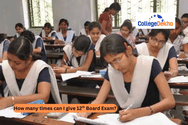- Karnataka 2nd PUC Chemistry Important Questions 2026 of 1 Mark
- Karnataka 2nd PUC Chemistry Important Questions 2026 of 2 Marks
- Karnataka 2nd PUC Chemistry Important Questions 2026 of 3 Marks
- Karnataka 2nd PUC Chemistry Important Questions 2026 of 5 Marks
- Which Chapters have more Weightage in Karnataka 2nd PUC Chemistry?


Never Miss an Exam Update
Karnataka 2nd PUC Chemistry Important Questions 2026 are some topics like Solutions, Electrochemistry, Chemical Kinetics, d and f block elements, etc. Within these topics, specific concepts like Raoult's law, Henry's law, colligative properties, electrode potential, and reaction mechanisms are very important. While going through the
Karnataka 2nd PUC Chemistry Syllabus 2025-26
, you can focus more on topics like electrochemical cells, Nernst equation, electrolytic conduction, and Faraday's laws, nomenclature, isomerism, bonding (VBT and CFT), and applications of coordination compounds to score good marks in class 12.
In Karnataka 2nd PUC Chemistry, the theory paper will be conducted for 70 marks. A total of 46 questions will be provided in the exam including MCQs, 1 mark questions, 2 mark questions, 3 mark questions, and 5 mark questions. The Karnataka 2nd PUC Chemistry question papers will be divided into 5 parts; Part A, Part B, Part C, Part D, and Part E. Part A contains 20 multiple-choice questions of 1 mark each. Part B has 6 questions, each for 2 marks. Part C includes 5 questions, each of 3 marks. Part D features 4 questions, each for 5 marks. Finally, Part E has 3 questions, each for 3 marks. In all sections except section A, students will get internal choices. Read the complete article to have more details on the Karnataka 2nd PUC Chemistry Important Questions 2026.
Karnataka 2nd PUC Chemistry Important Questions 2026 of 1 Mark
The Karnataka 2nd PUC Chemistry 1 mark questions are provided in Part-A that carries 20 marks. There are 20 questions in this section each carrying 1 mark. In Part-A questions, first attempted answer will be considered for awarding marks. Here are a few predicted 1 mark Karnataka 2nd PUC Chemistry Important Questions 2026:- The concentration term depends on temperature is
b) mole fraction
c) molality
d) molarity
- Identify the correct sequence of number of unpaired electrons of the following ions.
b) Fe3+> Ni2+> Ti+3> Cr3+
c) Fe3+ > Cr3+> Ni2+ > Ti+3
d) Fe3+ > Cr3+>Ti+3> Ni2+
- Statement I: Cu displaces H2 gas from dilute acids. Statement II: Cu2+ ions get reduced more easily than H+ ions
b) Both Statement I and II are incorrect
c) Statement I is correct and Statement II is incorrect.
d) Statement I is incorrect and Statement II is correct.
- Four haloalkane compounds represented by the letters M, N, O and P having boiling point are 24.2°C, 38°C, 3.56°C and 101.6°C respectively. Among the four compounds N most likely to be
b) CH3Br
c) C2H5Br
d) C3H7I
- Which of the following observation is shown by 2–methylpropan-2-ol with Lucas reagent?
b) No turbidity will be observed at room temperature.
c) Turbidity will be observed immediately.
d) Turbidity will be observed at room temperature but will disappear after five minutes.
- The transition metal present in red pigment of blood haemoglobin is
b) nickel
c) iron
d) copper.
- The geometry of the complex Fe(CO)5 is
b) tetrahedral
c) trigonal bipyramidal
d) square pyramidal
- An organic compound with the molecular formula C9H10O forms 2,4-DNP derivative, reduces Tollens’ reagent and undergoes Cannizzaro reaction. On vigorous oxidation, it gives 1,2benzenedicarboxylic acid. The organic compound is
b) 2-ethyl benzaldehyde
c) 4-ethyl benzaldehyde
d) 2, 3-dimethyl benzaldehyde.
- The correct order of basic strength in case of ethyl substituted amines in aqueous solution is
b) (C2H5)3N> (C2H5)2NH > C2H5NH2> NH3
c) (C2H5)3N> C2H5NH2> (C2H5)2NH > NH3
d) NH3> (C2H5)2NH > (C2H5)3N > C2H5NH2
- The rate at a particular moment of time is expressed as ___________ rate of reaction.
- The diamagnetic lanthanoid ion is __________.
- Williamson’s synthesis of preparing dimethyl ether involves ______ reaction for the attack of a methoxide ion on methyl chloride.
- Nucleotides are joined together by ________ linkage between 5 and 3 carbon atoms of pentose sugar.
- Write the IUPAC name of CH₃-O-C₂H₅.
- Aldehydes are more reactive than ketones towards nucleophilic addition reaction. Give one reason.
- What are copolymers?
- What is meant by "Selectivity of Catalyst"?
Karnataka 2nd PUC Chemistry Important Questions 2026 of 2 Marks
The 2 marks questions are provided in Part-B that carries 06 marks. You need to attend any 3 questions out of 6. Each question carries 2 marks. Here are a few predicted 2 marks Karnataka 2nd PUC Chemistry Important Questions 2026:
- Draw a graph of Potential energy Vs reaction Coordinate showing the effect of Catalyst on activation energy.
- Write the structures of Cis and trans isomers of [Pt(NH₃)₂Cl₂].
-
Complete the following equations:
(i) CH₃Br + KCN →
(ii) CH₃Br + CoF₂ → - Explain Clemmensen reduction reaction.
- Write any two nitrogenous base commonly found in both RNA and DNA.
- Write the expression to relate cryoscopic constant and change in enthalpy of fusion. Explain the terms involved in it.
- Give an example for female sex hormone and write its function.
- Name an important alloy, which contains maximum percentage of the lanthanoid metals. Mention one of its use.
- Explain Fittig’s reaction.
- An element crystallises in Face Centred Crystal [FCC] lattice. The edge length of the unit cell is 556 pm and it has density 1.55 gcm-31.55 gcm. Calculate the atomic mass of the element. [Given: N A =6.022×10 23 ].
- Define molarity [M]. How does molarity vary with temperature?
Karnataka 2nd PUC Chemistry Important Questions 2026 of 3 Marks
The 3 marks questions are provided in Part-C that carries 15 marks. You need to attend 5 questions out of 10. Each question carries 3 marks. Apart from this, the 3 marks questions will also be there in Part-E that carries 09 marks. You need to answer any 3 out of 6 questions. Each question carries 3 marks. Here are a few predicted 3 marks Karnataka 2nd PUC Chemistry Important Questions 2026:
- Using abbreviations of following ligands, identify the number of donor sites and write the formula of each ligand. b) EDTA c) PPh3 27. Write the equations for the preparation of potassium permanganate from pyrolusite ore, what is the colour of KMnO4 crystals?
- Using Valence Bond Theory [VBT], explain geometry, hybridisation and magnetic property of [CoF6]3– ion. [Atomic number of Cobalt is 27].
- Give any three applications of coordination compounds.
- Transition elements have higher enthalpy of atomization. Give two reasons. Among 3d and 4d series of transition elements, which series has higher enthalpy of atomization?
- What does P and ZAB represent in the equation: = Rate PZ e− AB E /RT a 2 × 3 = 06 ? Name a factor on which Z depends.
- Name the fuel cell used in Apollo space programme and write its anodic and cathodic reaction.
- Give any three differences between ideal and non -ideal solutions.
-
In the extraction of Aluminium metal by Hall-Heroult process.
a) Write overall cell reaction.
b) What is the role of Na 3 AlF 6 ?
c) On which electrode aluminium metal deposits. - With reaction conditions, write the balanced chemical equations for the manufacture of nitric acid by Ostwald's process.
-
Complete the following equations:
a) CaO+H 2 O→
b) SO2+H2O→SO
c) Na2SO3+H2O+SO2→ -
a) How is chlorine prepared in laboratory using KMnO4?
b) Why chlorine water on standing loses yellow colour? -
Give any three differences between Lyophilic Colloid and Lyophobic Colloid.
b) Write the expression of Freundlich adsorption isotherm. In this isotherm, what is the value of "1/n" to show that adsorption is independent of pressure. - The boiling point of benzene is 353.23 K when 1.80 g of a non-volatile solute was dissolved in 90 g of benzene, the boiling point is raised to 354.11 K. Calculate the molar mass of the solute (K_b for benzene is 2.53 K Kg mol⁻¹).
- Vapour pressure of compound 'A' (molar mass 120 g/mol) and compound "B" (molar mass 85g/mol) at 298 K are 200 mm Hg and 415 mm Hg respectively. Calculate the vapour pressure of the solution prepared by mixing 26.0 g of compound 'A' and 40 g of compound 'B' at 298 K.
Karnataka 2nd PUC Chemistry Important Questions 2026 of 5 Marks
You will find the 5 marks questions in Part-D that carries 20 marks. You need to answer any 4 out of 7 questions. Each question carries 5 marks. Here are a few predicted 5 marks Karnataka 2nd PUC Chemistry Important Questions 2026:- a) Write the reactions involved in the conversion of toluene to m-nitrobenzoic acid. b) The pKa values of acetic acid, benzoic acid and trifluoroacetic acid are 4.76, 4.19 and 0.23 respectively. Arrange them in the increasing order of acid strength. Justify the arrangement.
- a) Write the mechanism involved in the conversion of 2-bromo-2-methylpropane to 2-methylpropan-2-ol. b) What are enantiomers? Name one physical property which differs enantiomers.
- a) Give the mechanism involved in the acid catalyzed hydration of C2H4 to C2H5OH. b) Name the enzyme involved in fermentation of glucose into ethanol and write its chemical equation.
- An organic compound (X) with molecular formula C8H8O forms an orange-red precipitate with 2,4DNP reagent and gives yellow precipitate on heating with iodine in the presence of sodium hydroxide. It neither reduces Tollens reagent nor does it decolourise bromine water. On oxidation with chromic acid, ‘X’ gives a carboxylic acid (Y) having molecular formula C7H6O2. Identify the compounds (X) and (Y) and write all the reactions involved.
-
(a) Write the chemical equation for the reaction, when benzaldehyde is heated with concentrated alkali. Name the reaction.
(b) Among butan-2-one and Pentan-3-one which compound is oxidised by sodium hypohalite? Write its chemical equation. -
(a) Write the structure of Hinsberg reagent.
(b) Which type of amines reacts with Hinsberg reagent to give precipitate, which is soluble in NaOH? Write its chemical reaction.
Which Chapters have more Weightage in Karnataka 2nd PUC Chemistry?
Topics like Raoult's Law, Henry's Law, concentration of solutions, vapor pressure of liquid solutions, abnormal molar masses, and colligative properties are important for the exam. Focus on topics like electrochemical cells, Nernst equation, electrolytic conduction, and Faraday's laws in Electrochemistry. reaction rates, factors affecting reaction rates, order and molecularity of reactions, and integrated rate equations. are important from Chemical Kinetics. In Coordination Compounds, nomenclature, isomerism, bonding (VBT and CFT), and applications of coordination compounds are important. Apart from these, Aldehydes, Ketones, and Carboxylic Acids, Biomolecules, Metallurgy, Surface Chemistry, and Organic Chemistry Reactions are also key concepts to be focused on.Based on the questions and the important units/ topics that are mentioned in this article, you can start your preparation for the upcoming exam. Try not to do suggestive study; complete the entire syllabus and then solve the Karnataka Board Class 12 Chemistry previous year question papers for better result.
Are you feeling lost and unsure about what career path to take after completing 12th standard?
Say goodbye to confusion and hello to a bright future!

Was this article helpful?



















